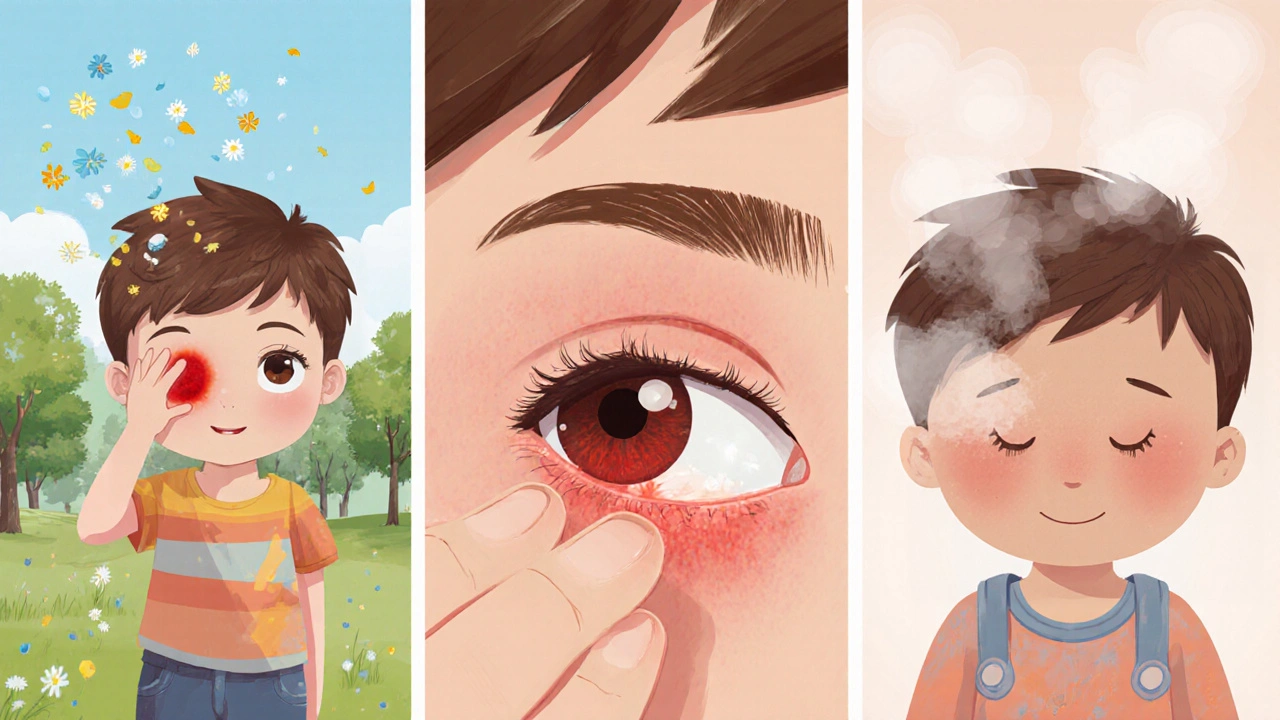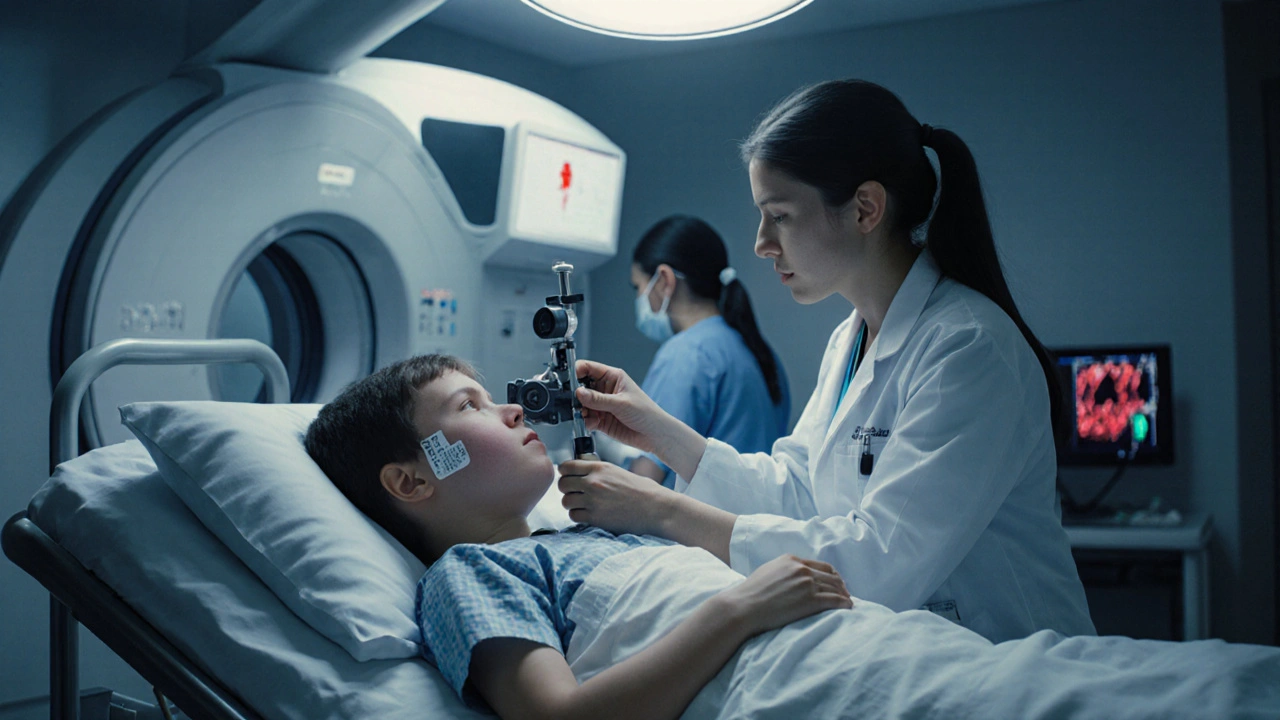Eye Swelling in Kids: Causes, Symptoms, and Treatment Guide
 Oct, 3 2025
Oct, 3 2025
Eye Swelling Symptom Checker
Select the symptoms your child is experiencing to identify possible causes and recommended treatments.
Itchy Eyes
Often associated with allergies or allergic conjunctivitis
Painful Lump on Eyelid
Could indicate a stye or chalazion
Red Eyes
May suggest infection or irritation
Fever
Indicates possible infection requiring medical attention
Vision Changes
Warning sign requiring immediate medical care
Rapidly Spreading Swelling
Could indicate serious infection
Quick Takeaways
- Most eye swelling in kids is harmless and clears with simple home care.
- Look for redness, pain, fever, or vision changes - these need a doctor.
- Allergies, styes, and mild infections are the top three culprits.
- Warm compresses, antihistamines, or antibiotics treat the majority of cases.
- Never ignore rapid swelling around the eye; it could signal orbital cellulitis.
When a child wakes up with a puffy eye, parents often panic. Eye swelling in children refers to any noticeable puffiness, redness, or fluid buildup around the eyelid or orbit that develops suddenly or over a few days. It can be a mild irritation or a sign of a serious infection. Understanding the most common triggers and how to respond can keep your child comfortable and avoid unnecessary ER trips.
What Exactly Is Eye Swelling?
Eye swelling, medically called periorbital edema the accumulation of fluid in the tissue surrounding the eye, appears as a soft, often tender bulge on the eyelid. It may be unilateral (one eye) or bilateral (both eyes). The swelling can involve the eyelid skin, the inner lining (conjunctiva), or the space behind the eye (orbit). In children, the skin is thinner, so changes become visible quickly.
Common Causes in Children
Below are the leading reasons kids develop periorbital edema, grouped by how they arise.
Allergic Reactions
Allergic conjunctivitis an inflammation of the eye caused by allergens such as pollen, pet dander, or dust mites triggers itching, tearing, and a hazy look. The eyelids swell because histamine makes tiny blood vessels leak fluid. Seasonal allergies are the usual culprit, but new soaps, detergents, or cosmetics can also provoke a reaction.
Infections
- Stye (hordeolum) a painful, red lump caused by a blocked oil gland at the edge of the eyelid. It often looks like a pimple and may ooze.
- Chalazion a non‑painful nodule formed when a deeper oil gland becomes clogged. Swelling is slower but can become large.
- Conjunctivitis (pink eye) a viral or bacterial infection that reddens the white of the eye and may produce a sticky discharge. Swelling accompanies the redness.
- Pre‑septal cellulitis a bacterial infection of the eyelid and surrounding skin, usually from a scratch or insect bite. The area becomes hot, tender, and may spread.
- Orbital cellulitis a deeper infection behind the eye that can threaten vision and requires urgent care. Symptoms include severe pain, fever, and limited eye movement.
Trauma
Even a minor bump can rupture tiny blood vessels, leading to a bruise‑like puffiness called a black eye periorbital bruising resulting from blunt force. If the child reports vision loss, double vision, or persistent pain, an eye doctor should examine them for internal injury.
Sinus or Dental Infections
Upper‑jaw tooth abscesses or chronic sinusitis can drain into the orbit, causing swelling that mimics an eye infection. The pain often radiates toward the cheek or jaw, and fever may be present.
Systemic or Autoimmune Conditions
Rarely, diseases such as juvenile idiopathic arthritis or lupus produce eye inflammation (uveitis) that shows up as eyelid swelling. In these cases, swelling is often accompanied by joint pain, rash, or fatigue.

Red‑Flag Symptoms: When to Seek Immediate Care
Most eye puffiness resolves at home, but watch for these warning signs:
- Fever above 38°C (100.4°F)
- Severe pain that worsens over hours
- Swelling that spreads quickly across the brow or cheek
- Restricted eye movement or double vision
- Vision blurriness or loss of sight
- Rapidly increasing size of a lump
These symptoms suggest orbital cellulitis or another serious infection and demand urgent evaluation by a pediatrician or ophthalmologist.
Treatment Options by Cause
Below is a practical guide on how to manage each common cause.
Allergic Conjunctivitis
- Antihistamine eye drops (e.g., ketotifen) - apply twice daily.
- Oral antihistamines for systemic relief.
- Cold compresses for 10‑15 minutes, three times a day.
- Identify and remove the allergen (keep windows closed during pollen peaks, use dust‑mite‑proof bedding).
Stye (Hordeolum)
- Warm compresses - 5 minutes, 3‑4 times daily to soften the blockage.
- Keep the eyelid clean; gentle massage toward the inner corner.
- If no improvement in 48‑72hours, a doctor may prescribe a topical antibiotic ointment.
Chalazion
- Continue warm compresses for 10‑15 minutes, twice daily for 2‑3 weeks.
- Gentle lid massage after each compress.
- Persistent or large chalazion may need a steroid injection or minor surgical removal.
Conjunctivitis
- Viral “pink eye” - usually self‑limiting; use lubricating drops and hygiene (hand washing, avoid touching eyes).
- Bacterial “pink eye” - pediatrician may prescribe topical antibiotics such as erythromycin ointment.
- Isolation from school until 24 hours after symptom improvement reduces spread.
Pre‑septal Cellulitis
- Oral antibiotics covering Staphylococcus and Streptococcus (e.g., amoxicillin‑clavulanate) for 7‑10 days.
- Warm compresses to reduce tenderness.
- Follow‑up eye exam to ensure the infection doesn't progress.
Orbital Cellulitis
- Immediate emergency department visit.
- IV antibiotics (e.g., ceftriaxone plus vancomycin) for 24‑48hours, then oral course.
- Possible CT scan to assess spread.
- Hospital stay may be required for close monitoring of vision.
Trauma‑Related Swelling
- Cold compresses for the first 24hours to limit bruising.
- Analgesic such as acetaminophen (dosage per weight) for pain.
- If vision changes, seek ophthalmology review.
Sinus or Dental Source
- Dental evaluation and possible drainage of an abscess.
- Course of antibiotics (amoxicillin‑clavulanate) if bacterial.
- ENT consultation for chronic sinusitis.
Prevention Tips for Parents
- Teach kids to wash hands frequently and avoid rubbing eyes.
- Keep fingernails trimmed to reduce the chance of nail‑bed infections.
- Use hypoallergenic soaps and avoid scented eye makeup.
- Maintain up‑to‑date vaccinations (e.g., Haemophilus influenzae typeb) that lower risk of severe infections.
- Schedule routine dental check‑ups; untreated cavities can spread.
Comparison of Common Causes and First‑Line Treatments
| Cause | Main Symptom | First‑Line Treatment | When to See a Doctor |
|---|---|---|---|
| Allergic conjunctivitis | Itchy, watery eyes; mild swelling | Cold compress + antihistamine drops | Swelling persists > 48h or vision blurs |
| Stye (hordeolum) | Red, painful lump at eyelid margin | Warm compresses 3‑4×/day | No improvement in 3days or spreading redness |
| Chalazion | Firm, non‑tender bump | Warm compresses + lid massage | Size > 5mm after 2weeks |
| Pre‑septal cellulitis | Warm, tender swelling, no eye movement limitation | Oral antibiotics (amoxicillin‑clavulanate) | Fever, worsening pain, or eye movement pain |
| Orbital cellulitis | Severe pain, fever, limited eye movement | IV antibiotics, possible hospital stay | Any sign of orbital involvement - go to ER |
| Trauma (black eye) | Bruising, mild swelling | Cold compress, analgesic | Vision loss, double vision, or persistent pain |

Frequently Asked Questions
Can eye swelling be a sign of a serious illness?
Yes. While most cases are mild, rapid swelling with fever, pain, or vision changes can indicate orbital cellulitis, which requires urgent treatment to prevent permanent damage.
How long should I use a warm compress for a stye?
Apply a clean, warm (not hot) compress for 5‑10 minutes, three to four times a day. Most styes start draining within 48‑72 hours.
Are over‑the‑counter eye drops safe for kids?
Lubricating drops are generally safe, but antihistamine or decongestant drops should be used only after a pediatrician’s advice, especially for children under six.
When should I call my pediatrician instead of waiting?
If the swelling is accompanied by fever, painful eye movement, double vision, or the child complains of severe pain, call the pediatrician or go to the emergency department right away.
Can allergies cause swelling on both eyes?
Yes. Seasonal or indoor allergens often affect both eyes simultaneously, leading to bilateral puffiness, itching, and watery discharge.

Jennifer Grant
October 3, 2025 AT 09:04When we look at the simple swelling of a child's eye, we are really peering into a microcosm of the body's defensive ballet, a theatre of inflammation that whispers deeper truths about health.
Each puff of fluid is not just a random puff, but a cascade of histamines, bacteria, or even the tiny dust that has slipped past our vigilant eyelids.
The child experiences discomfort, yet the adult watches, sometimes panicking, sometimes soothing, and often learning the language of the body.
Allergic conjunctivitis, for instance, is a reminder that the environment is constantly speaking to us, and we ignore its messages at our peril.
A stye, that stubborn little boil, is a lesson in how even the smallest of glands can become clogged and erupt.
In many cultures, the old wives' tale of "warm compresses" persists, and modern medicine validates this gentle heat as a way to loosen blockages.
The presence of fever with swelling is a red flag that the infection may have traversed beyond superficial layers.
Orbital cellulitis, the dreaded deep infection, can threaten vision if not addressed promptly, underscoring the need for urgent care.
Yet not every puffy eye demands a hospital; most cases resolve with cold compresses, hygiene, and a watchful eye.
Parents often wonder about the appropriate duration for compresses, but generally five to ten minutes, three times a day, suffices for styes.
When antibiotics are necessary, the choice of topical versus oral reflects the pathogen's location and severity.
Dental infections can masquerade as eye swelling, a reminder that the mouth and sinuses share pathways with the orbit.
Systemic autoimmune conditions, though rare, can manifest as periorbital edema, tying the eye's health to the whole body's immune balance.
Prevention, however, remains the cornerstone: hand washing, avoiding eye rubbing, and maintaining up‑to‑date vaccinations.
Ultimately, the child's resilience often shines through, and with proper care, the swelling fades, leaving behind a lesson about vigilance and compassion.
So keep an eye on the eyes, and let the tiny signs guide you toward timely help.
Kenneth Mendez
October 6, 2025 AT 19:10Theyve been hiding the real cure for eye infections from us.
Gabe Crisp
October 10, 2025 AT 05:16Seeing a kid with a swollen eye should trigger a moral duty to seek professional care before dismissing it as "just allergies." The community often downplays the seriousness, but negligence can lead to vision loss. It’s essential to recognize red‑flag symptoms like fever or rapid swelling and act responsibly. Ignoring these signs feels like a betrayal of parental responsibility. We owe our children better than complacent guesses.
Paul Bedrule
October 13, 2025 AT 15:23In the ontological schema of ocular pathology, periorbital edema functions as an epiphenomenal indicator of systemic perturbations. The etiological vector can be bifurcated into immunologic hypersensitivity cascades and microbial invasion algorithms. Diagnostic heuristics should therefore integrate both immunopathological and microbiological parameters. Therapeutic protocols must be calibrated to the pathogenetic substrate, employing either antihistaminic modulators or bactericidal agents. Failure to operationalize this multi‑modal approach risks iatrogenic sequelae.
yash Soni
October 17, 2025 AT 01:29Oh great, another kid with a puffy eye – because the world needed more drama. Just slap a cold pack on it, tell them to stop rubbing, and move on. If it gets worse, maybe then call a doctor, but who has time?
Emily Jozefowicz
October 20, 2025 AT 11:35Well, look at that, a swollen eyelid is basically the universe's way of saying “pay attention”. Colourful tip: a warm compress is your budget-friendly spa treatment for that tiny stye. If the kid starts yelling about pain or you see a fever, upgrade to a real doctor appointment – not just a WebMD search. Remember, kids bounce back fast when we give them proper care, so don’t over‑think it.
Franklin Romanowski
October 23, 2025 AT 21:42Hey folks, I get how scary it can be when your little one wakes up with a puffy eye. Most of the time it’s just a harmless allergy or a tiny stye that will melt away with warm compresses. Keep an eye on any fever or vision changes, and you’ll know when it’s time to call the pediatrician. A little patience and some gentle care usually do the trick.
Brett Coombs
October 27, 2025 AT 06:48Most of this stuff is just hype, honestly.
John Hoffmann
October 30, 2025 AT 16:54The information presented is mostly accurate, but a few clarifications are needed. Warm compresses should be applied for 5‑10 minutes, not longer, to avoid skin irritation. Antibiotic ointments are indicated only for bacterial infections confirmed by a clinician. Over‑use of eye drops can disrupt the tear film. Overall, the guide is useful when followed with professional advice.
Shane matthews
November 3, 2025 AT 03:01Eye swelling is usually not a big deal just keep it clean and watch for fever
Rushikesh Mhetre
November 6, 2025 AT 13:07Alright team! 🚀 When you see a child’s eye puff up, jump into action with a cold compress-5 minutes, three times a day! 💪 If there’s any fever, pain, or vision blur, dial your pediatrician ASAP! 🌟 Remember, early intervention can prevent serious complications! 🎉 Stay vigilant and keep those eyes happy! 🙌
Sharath Babu Srinivas
November 9, 2025 AT 23:13Proper eye care requires consistency 😊. Apply warm compresses for 5‑10 minutes, 3‑4 times daily 👍. Avoid touching the eye with dirty hands 🚫. If symptoms persist beyond 48 hours, seek medical evaluation 🏥. 👀
Halid A.
November 13, 2025 AT 09:19In summary, the primary approach to pediatric periorbital edema involves distinguishing benign causes from emergent conditions. Conservative measures such as cold or warm compresses, antihistamines, and hygiene are appropriate for mild presentations. However, the presence of systemic signs-fever, pain, or visual disturbance-necessitates prompt professional evaluation. Adhering to this algorithm ensures both safety and effective treatment.
Brandon Burt
November 16, 2025 AT 19:26Honestly, reading through this whole guide felt like wading through a sea of medical jargon that could have been trimmed down to the essentials; the endless bullet points and tables are a bit much for a parent who just wants to know if that little bump is dangerous; the repeated advice about warm compresses, while useful, borders on redundancy, and the warnings about orbital cellulitis, although critical, could have been highlighted earlier in the article for better emphasis; also, the inclusion of dental and sinus connections, while thorough, may overwhelm someone looking for quick answers; still, I guess the thoroughness does have its merits for those who appreciate depth.
Gloria Reyes Najera
November 20, 2025 AT 05:32U can just use any eye drop it works for everything
Gauri Omar
November 23, 2025 AT 15:38Listen up, the swelling isn’t just a tiny annoyance; it's the body's SOS alarm screaming that something's off, and if you ignore it, you’re basically flirting with disaster. So grab that cold pack, watch for fever, and don’t be a hero – call the doc before it turns into a nightmare.
Willy garcia
November 27, 2025 AT 01:45Stay calm keep the compress on and monitor the kid's symptoms
zaza oglu
November 30, 2025 AT 11:51Kids get puffy eyes all the time-think allergies, styes, or a tiny bump from play-so a gentle warm compress, a bit of clean eyelid care, and a watchful eye on any fever or vision change is all you need! If anything looks off, a quick pediatric visit keeps everything on track.
Vaibhav Sai
December 3, 2025 AT 21:57Hey there! 🌈 A swollen eye in a child is usually just a minor irritation-apply a warm compress 🕶️, keep the area clean, and watch for fever or blurry vision 👀. If those red flags show up, ping your pediatrician right away-better safe than sorry! 🎈
mark Lapardin
December 7, 2025 AT 08:04Balancing the need for immediate care with reassurance, the guide emphasizes that most eye swellings are benign yet cautions against overlooking systemic signs; this dual approach helps parents act wisely without panic.